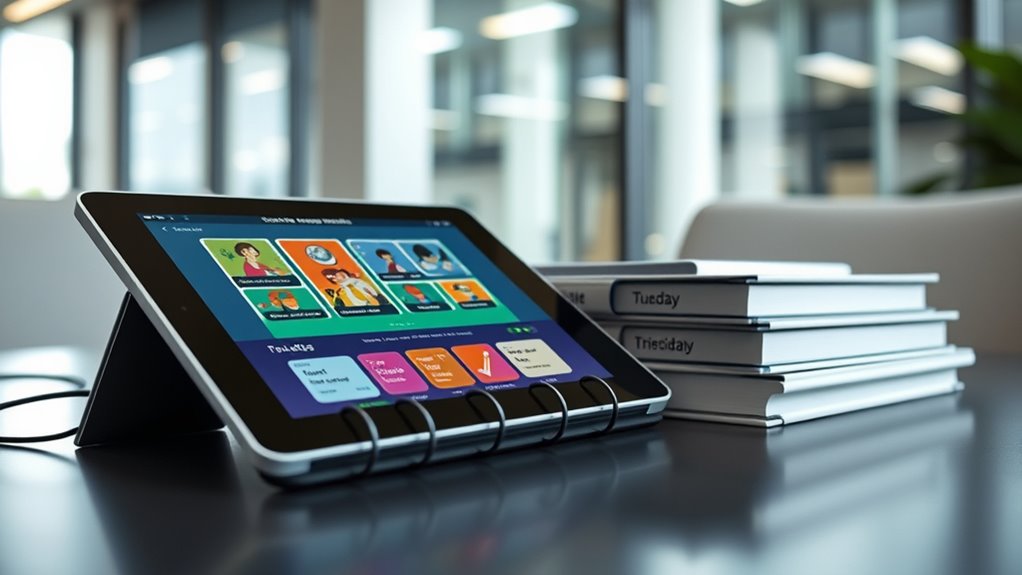To improve retention, combine microlearning with spaced repetition by taking short, focused modules and reviewing them at strategic intervals. This approach helps reinforce long-term memory by breaking down complex topics into manageable parts and revisiting them over increasing periods. Digital tools can automate scheduling and tracking, while interactive elements like quizzes boost engagement. Mastering these techniques makes learning more effective—and if you keep exploring, you’ll discover how to maximize their benefits even further.
Key Takeaways
- Break content into short, focused modules under 10 minutes to enhance engagement and reduce mental fatigue.
- Implement spaced review intervals that gradually increase to reinforce long-term memory retention.
- Use interactive tools like quizzes and flashcards for immediate feedback and active learning.
- Leverage digital platforms and LMS for automated scheduling and personalized review cycles.
- Regularly analyze engagement and performance data to refine content and optimize retention strategies.
The Power of Microlearning in Modern Education

Microlearning has revolutionized modern education by making learning more efficient and engaging. You can now access focused, bite-sized content that fits into your busy schedule, reducing overwhelm and boosting understanding. This approach simplifies complex topics into manageable units, helping you grasp concepts faster and retain information longer. Research shows microlearning increases long-term retention rates and improves knowledge transfer by about 75%. It also enhances your engagement, with higher course completion rates and greater satisfaction. By breaking content into short, targeted modules—often under 10 minutes—you stay motivated and avoid mental fatigue. Whether you’re a student or a professional, microlearning provides a flexible, effective way to learn new skills and stay updated in today’s fast-paced world. When combined with spaced repetition, it can further strengthen your memory and mastery of the material.
How Spaced Repetition Enhances Memory Retention

Spaced repetition considerably boosts your ability to retain information by timing review sessions strategically over increasing intervals. This approach strengthens your memory by reinforcing knowledge just as it begins to fade, making recall more automatic. When you revisit material at ideal moments, you prevent the forgetting curve from taking hold, which helps solidify long-term retention. Incorporating spaced repetition with microlearning content naturally aligns because short, focused modules are easy to review multiple times. This method also reduces cognitive overload, allowing you to revisit topics without feeling overwhelmed. Over time, your ability to recall information improves markedly, making learning more efficient. Using comfort solutions for sofa beds or other supportive products during review sessions can make studying more relaxing, which enhances retention. By consistently applying spaced repetition, you turn short-term gains into lasting knowledge, boosting your confidence and mastery over new skills.
Combining Microlearning With Spaced Repetition for Optimal Results

Integrating microlearning with spaced repetition creates a powerful synergy that maximizes learning retention and engagement. By delivering short, focused modules repeatedly over increasing intervals, you reinforce knowledge and prevent forgetting. This approach leverages microlearning’s efficiency and spaced repetition’s strength in long-term retention. To implement effectively, tailor the review schedule based on difficulty and learner progress. Use varied formats like quizzes, summaries, or videos to keep it dynamic. Here’s a quick guide:
| Step | Action | Benefit |
|---|---|---|
| Break content into small units | Focus on key concepts | Easier to review regularly |
| Schedule spaced reviews | Use increasing intervals | Strengthens memory retention |
| Incorporate active recall | Quizzes and questions | Boosts engagement and recall |
| Track progress | Adjust review timing | Optimizes learning flow |
Effective content segmentation ensures that learners can grasp concepts easily and review material efficiently.
Strategies for Implementing Effective Microlearning Modules

To create effective microlearning modules, you need to focus on designing clear, concise content that targets specific learning objectives. Incorporate spaced review sessions and interactive elements like quizzes or gamification to boost retention and engagement. By balancing these strategies, you’ll enhance learning outcomes and guarantee your modules are both impactful and user-friendly. Additionally, understanding toilet flushing mechanisms can help tailor content that addresses common issues and solutions, making your modules more relevant and practical for learners.
Designing Focused Content
Creating effective microlearning modules starts with designing focused content that targets specific learning objectives. You should break down complex topics into bite-sized units, each addressing a single, clear goal. Use straightforward language and avoid unnecessary details that could distract learners. Incorporate visuals, infographics, or short videos to enhance understanding and retention. Prioritize high-impact information, and guarantee each module has a well-defined beginning, middle, and end. Keep modules concise—ideally under 10 minutes—to match learners’ attention spans. Use active voice and direct instructions to engage your audience. Regularly review and refine content based on learner feedback and performance metrics. This targeted approach ensures your microlearning modules are effective, engaging, and aligned with your overall training goals. Additionally, tailoring content to Gold IRA considerations can help learners better understand investment options in the precious metals market.
Incorporating Spaced Reviews
Incorporating spaced reviews into microlearning modules enhances long-term retention by strategically revisiting content at increasing intervals. To do this effectively, design your modules so learners revisit key concepts after one day, then a few days later, and again after a week or more. Use automated systems or reminders to prompt these reviews, ensuring learners don’t forget vital information. Break content into small, focused units, then distribute review sessions across different modules or timeframes. Incorporate quick quizzes or summaries during each review to reinforce understanding. This approach aligns with natural memory consolidation processes, preventing forgetting curves. Additionally, understanding the principles of spaced repetition can help you optimize review timing for maximum retention. By intentionally scheduling spaced reviews, you maximize retention without overwhelming learners, making microlearning both efficient and impactful for long-term knowledge retention.
Utilizing Interactive Elements
Utilizing interactive elements in microlearning modules considerably boosts learner engagement and retention. When you include quizzes, simulations, or gamified features, you create active learning experiences that keep learners involved. Interactive components encourage immediate application of knowledge, reinforcing understanding and memory. For example, quick quizzes after a lesson help learners test their grasp, while clickable scenarios can simulate real-world decisions. Incorporating leaderboards or badges adds a competitive edge, motivating learners to complete modules. These elements break up passive content consumption, reducing fatigue and maintaining attention. When you design microlearning with engaging interactions, you foster a more dynamic and memorable learning environment. This approach not only improves retention but also boosts motivation, making learners more likely to complete modules and apply what they’ve learned. Incorporating effective training strategies can further enhance the impact of your microlearning initiatives.
Leveraging Technology to Support Repetitive Learning Cycles

Technology plays a crucial role in supporting repetitive learning cycles by enabling seamless delivery and management of spaced repetition strategies. You can use learning management systems (LMS) and specialized apps to schedule reviews automatically, ensuring content is revisited at ideal intervals. These tools track your progress, adapt repetition schedules based on your performance, and send timely reminders to reinforce learning. Mobile platforms make it easy to review content anytime, anywhere, maximizing engagement and retention. Interactive features like quizzes and flashcards integrated into these tools further enhance spaced repetition by providing immediate feedback. Additionally, high refresh rates in digital learning tools can improve the visual experience and increase user engagement. By leveraging technology, you streamline the repetition process, reduce manual planning, and create personalized learning experiences that strengthen long-term memory. This approach makes consistent review more efficient and effective.
Measuring Success: Outcomes of Microlearning and Spaced Repetition

You can see how microlearning and spaced repetition boost retention rates, with studies showing up to 75% long-term knowledge retention. Tracking knowledge transfer metrics reveals improved application and performance, demonstrating real organizational impact. Engagement and completion data further confirm that short, interactive modules keep learners motivated and returning for more. Additionally, incorporating goal setting techniques can enhance the effectiveness of these methods by aligning learning objectives with personal development strategies.
Retention Rate Improvements
Microlearning combined with spaced repetition considerably boosts retention rates, making training more effective and measurable. You’ll notice improved long-term memory retention, with studies showing an average of 75% retention compared to traditional methods. This synergy ensures that knowledge stays with you longer, reducing forgetting. To illustrate, consider the following factors:
| Factor | Impact |
|---|---|
| Repetition Frequency | Increases retention through timely review |
| Content Relevance | Enhances engagement and motivation for consistent review |
| Spaced Intervals | Prevents cognitive overload, supporting long-term storage |
Knowledge Transfer Metrics
Measuring the success of microlearning and spaced repetition involves evaluating how effectively these methods transfer knowledge into practical application. You can track this through performance improvements, skill acquisition rates, and real-world task execution. For example, organizations report a 35% increase in knowledge application post-training, indicating effective transfer. You might also assess behavioral changes, such as increased compliance or faster decision-making, which reflect the practical use of learned skills. Additionally, testing before and after microlearning sessions reveals knowledge gains, while supervisor feedback offers insights into how well learners apply concepts on the job. These metrics provide a clear picture of whether microlearning and spaced repetition translate into measurable improvements in workplace performance and skill retention. Furthermore, tracking learning transfer helps determine the long-term effectiveness of these techniques.
Engagement and Completion Data
Engagement and completion rates are key indicators of microlearning’s effectiveness, demonstrating how well learners interact with and finish their courses. High rates show that microlearning keeps learners motivated and committed. For example, gamified modules can reach up to 90% completion, while traditional courses hover around 20%. Short, interactive content reduces mental fatigue and aligns with human attention spans, boosting participation. Here’s a quick comparison:
| Method | Completion Rate |
|---|---|
| Traditional eLearning | About 20% |
| Microlearning (average) | 75-80% |
| Gamified Microlearning | Up to 90% |
These figures reveal microlearning’s power to foster sustained engagement, leading to better learning outcomes and higher satisfaction.
Frequently Asked Questions
How Does Microlearning Impact Long-Term Knowledge Retention?
Microlearning considerably boosts your long-term knowledge retention by breaking content into small, focused units that are easier to remember. It achieves around 75% retention rates and increases knowledge transfer efficiency by about 30%. When combined with spaced repetition, it reinforces learning at ideal intervals, preventing forgetting. Additionally, short, engaging modules keep you motivated and reduce mental fatigue, ensuring you retain information longer and apply it more effectively in real-world situations.
What Are Best Practices for Designing Microlearning Modules?
To design effective microlearning modules, focus on clear, specific learning objectives and keep content concise, ideally under 10 minutes. Use engaging multimedia like videos and quizzes to boost interactivity. Incorporate spaced repetition naturally by reviewing key points across modules. Guarantee mobile accessibility for anytime learning, and include interactive elements to sustain motivation. Regularly gather feedback to refine content, making it relevant and aligned with learners’ needs.
How Can Organizations Effectively Implement Spaced Repetition Strategies?
To implement spaced repetition effectively, you should schedule reviews of key content at increasing intervals, such as after one day, a week, then a month. Incorporate automated reminders or quizzes to prompt learners to revisit material regularly. Use microlearning modules that naturally lend themselves to repetition, like short videos or quick quizzes, and track progress to adjust intervals based on individual retention. This approach boosts long-term memory retention and skill mastery.
What Technology Tools Support Microlearning and Spaced Repetition Integration?
You can use Learning Management Systems (LMS) like Moodle or TalentLMS that support microlearning modules and enable scheduling spaced repetitions. Mobile apps such as Duolingo or Anki are great for personal microlearning with spaced repetition features. Additionally, tools like EdApp and Axonify integrate gamification and interactive content, helping you deliver engaging microlearning experiences while automatically scheduling reviews to boost long-term retention.
How Do Engagement Levels Vary Across Different Microlearning Delivery Methods?
You’ll find engagement soars with gamified microlearning modules, where interactive quizzes and leaderboards captivate you, versus traditional video lessons that might feel passive. Short, targeted modules that fit your busy schedule keep your attention sharp, unlike lengthy courses that cause fatigue. Mobile-accessible formats let you learn anytime, anywhere, boosting motivation. Ultimately, the most engaging methods combine interactivity, brevity, and flexibility, making learning both enjoyable and effective, regardless of the delivery style.
Conclusion
By combining microlearning and spaced repetition, you can enhance your retention by up to 80%. This powerful duo makes learning more engaging and effective, helping you remember information longer and with less effort. Implementing these techniques with the right technology ensures consistent progress. So, start small, stay consistent, and watch your knowledge grow—because smarter learning today leads to greater success tomorrow.









